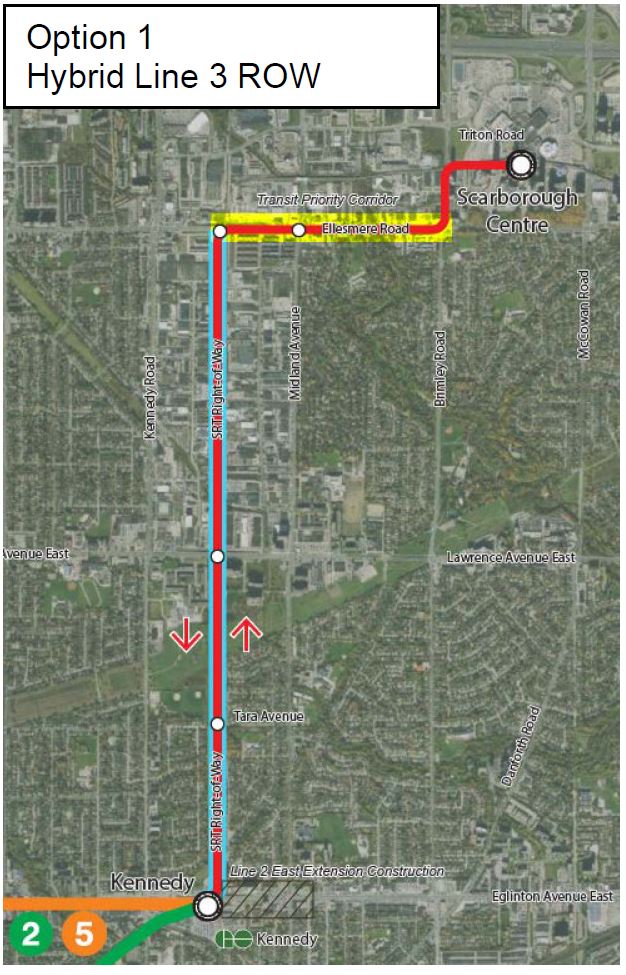The Scarborough RT may be nearing the end of its life, but it’s set to be reborn as a bus line.
In
a report released Thursday, TTC staff recommend converting a portion of the Scarborough RT’s right-of-way into a dedicated busway when the RT shuts down at the end of 2023.
Thirty-seven years after it opened, the notoriously unreliable RT has already outlived its intended design life by a decade, and is scheduled to be replaced by the province’s controversial three-stop, $5.5-billion Scarborough subway extension. But that project won’t be done until 2030 at the earliest, and in the meantime Scarborough transit riders will be stuck taking buses.
After examining options for replacement bus service, TTC staff determined adapting a roughly four kilometre portion of the RT route to allow buses to run in their own dedicated corridor “will provide customers with higher-quality service, and require less operating costs compared to just using regular city streets.” The recommendation will go to the TTC board next Thursday for approval.
The conversion of the right-of-way wouldn’t begin until the RT stops running, and would take until 2025 to complete. The TTC estimates it would cost $49.5 million, a figure that includes removing existing track and train systems, paving the right-of-way, and building new bus stops.
Transit advocacy group TTCriders welcomed the busway proposal, which it says is “the fastest and most reliable replacement option.”
But in a news release the group said the city needs to act fast to implement measures like on-street bus lanes and transit signal priority, in order to ensure buses match current RT service levels during the two years when the conversion is under construction and replacement buses will operate on the street.
“Politicians must act now to keep Scarborough connected,” said TTCriders member Elahveyini Veemharaj Aswaththaman.
Under the TTC proposal, the ground-level portion of the RT right-of-way between Kennedy and Ellesmere Stations would be converted to a busway, with stops at Tara Avenue, Lawrence Avenue East and Ellesmere Road.
Between Ellesmere Station and Scarborough Centre Station, where the RT runs on an elevated guideway, replacement buses would operate on-street, via Ellesmere Road and Brimley Road. The RT stations at Midland and McCowan would be shut down.
Local advocates have proposed repurposing decommissioned parts of the RT for community uses, like an elevated park. The TTC says it will continue to explore those options for sections not needed for the busway.
Although TTC staff believe the right-of-way option will offer Scarborough riders the best service, trips will still be longer than they are on the RT. According to the report, the RT takes about 10 minutes to get from Scarborough Centre and Kennedy, while using the busway it will take about 15 minutes. Between 2023 and 2025 when the conversion of the right-of-way is under construction, the trip will take 25 minutes using on-street buses.
In addition to the almost $50 million needed to convert the RT right-of-way, the TTC estimates replacement bus service will also require almost $60 million in capital funding to modify the platforms at Kennedy and Scarborough Centre stations, build a temporary bus terminal at Kennedy, and keep the RT operational until 2023. More than $62 million of the $108 million total isn’t funded.
The replacement bus service will also cost an additional $67.8 million to operate between 2023 and 2030, which is also unfunded.
The TTC and city are in talks with the provincial government, which is in charge of the subway plan, about covering the costs.
Coun. Paul Ainslie (Ward 24, Scarborough-Guildwood) said seven years of bus trips and millions of dollars in extra expenses could have been avoided if the city and province had stuck with the original plan of replacing the RT with a cheaper light rail transit (LRT) line that would have served more people. The LRT was scrapped in 2013.
In the course of the decade-long political dispute about Scarborough transit, proponents of the subway promised there would be a seamless transition from the RT closure to the opening of the subway, but Ainslie said that was always “a pie-in-the-sky fantasy.”
“I will always be disappointed that we’re going to spend tens of millions of dollars doing this (replacement bus plan), when if we had stuck with the original LRT it would have been built by now,” Ainslie said.





